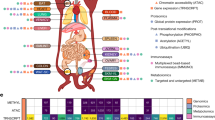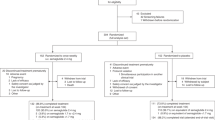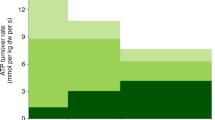Abstract
Background:
Aerobic exercise is recommended for weight management but energy balance is often less negative than predicted from exercise energy expenditure (ExEE).
Objective:
To examine effects of active commuting and leisure-time exercise on fat loss in women and men with overweight and obesity.
Methods:
We randomized 130 younger, physically inactive women and men with overweight and obesity (body mass index: 25–35 kg m−2) to 6 months of habitual lifestyle (control; CON, n=18), active commuting (BIKE, n=35) or leisure-time exercise of moderate (MOD, 50% VO2peak reserve, n=39) or vigorous intensity (VIG, 70% VO2peak reserve, n=38). The primary outcome was change in fat mass measured by dual-energy X-ray absorptiometry, which was analyzed intention-to-treat. Accumulated energy balance was calculated based on changes in body composition, and ExEE was calculated based on heart rate monitoring during exercise.
Results:
Testing at 3 and 6 months was completed by 95 and 90 participants, respectively. Fat mass was reduced after 3 and 6 months in BIKE (3 months: −3.6 (−5.5; −1.7) kg (mean (95% CI)); 6 months: −4.2 (−6.6; −1.9) kg; both: P<0.001), MOD (3 months: −2.2 (−3.9; −0.4) kg; 6 months: −2.6 (−4.8; −0.5) kg, both: P<0.02) and VIG (3 months: −3.4 (−5.2; −1.7) kg; 6 months: −4.5 (−6.6; −2.3) kg; both: P<0.001) compared with CON. Furthermore, fat loss was greater in VIG compared with MOD (6 months: −1.8 (−3.6; −0.1) kg, P=0.043). Based on the ExEE and the accumulated energy balance MOD compensated for the ExEE (77 (48; 106) %) but not BIKE (38 (−18; 95) %) and VIG (21 (−14; 55) %).
Conclusions:
A meaningful fat loss was obtained by 6 months of active commuting and leisure-time exercise, but fat loss was greater with vigorous compared with moderate intensity exercise. Active commuting is an alternative to leisure-time exercise in the management of overweight and obesity. The trial was registered at clinicaltrials.gov as NCT01962259 (main trial) and NCT01973686 (energy metabolism sub-study).
This is a preview of subscription content, access via your institution
Access options
Subscribe to this journal
Receive 12 print issues and online access
$259.00 per year
only $21.58 per issue
Buy this article
- Purchase on Springer Link
- Instant access to full article PDF
Prices may be subject to local taxes which are calculated during checkout




Similar content being viewed by others
References
Donnelly JE, Blair SN, Jakicic JM, Manore MM, Rankin JW, Smith BK . Appropriate physical activity intervention strategies for weight loss and prevention of weight regain for adults. Med Sci Sports Exerc 2009; 41: 459–471.
Miller WC, Koceja DM, Hamilton EJ . A meta-analysis of the past 25 years of weight loss research using diet, exercise or diet plus exercise intervention. Int J Obes Relat Metab Disord 1997; 21: 941–947.
Shaw K, Gennat H, O’Rourke P, Del Mar C . Exercise for overweight or obesity. Cochrane Database Syst Rev 2006; CD003817.
Garrow JS, Summerbell CD . Meta-analysis: effect of exercise, with or without dieting, on the body composition of overweight subjects. Eur J Clin Nutr 1995; 49: 1–10.
Thomas DM, Bouchard C, Church T, Slentz C, Kraus WE, Redman LM et al. Why do individuals not lose more weight from an exercise intervention at a defined dose? An energy balance analysis. Obes Rev 2012; 13: 835–847.
Sumithran P, Prendergast LA, Delbridge E, Purcell K, Shulkes A, Kriketos A et al. Long-term persistence of hormonal adaptations to weight loss. N Engl J Med 2011; 365: 1597–1604.
Martin CK, Heilbronn LK, de Jonge L, DeLany JP, Volaufova J, Anton SD et al. Effect of calorie restriction on resting metabolic rate and spontaneous physical activity. Obesity 2007; 15: 2964–2973.
Leibel RL, Rosenbaum M, Hirsch J . Changes in energy expenditure resulting from altered body weight. N Engl J Med 1995; 332: 621–628.
Heilbronn LK, de Jonge L, Frisard MI, DeLany JP, Larson-Meyer DE, Rood J et al. Effect of 6-month calorie restriction on biomarkers of longevity, metabolic adaptation, and oxidative stress in overweight individuals: a randomized controlled trial. JAMA 2006; 295: 1539–1548.
Goldsmith R, Joanisse DR, Gallagher D, Pavlovich K, Shamoon E, Leibel RL et al. Effects of experimental weight perturbation on skeletal muscle work efficiency, fuel utilization, and biochemistry in human subjects. Am J Physiol Regul Integr Comp Physiol 2010; 298: R79–R88.
Wilmore JH, Stanforth PR, Hudspeth LA, Gagnon J, Daw EW, Leon AS et al. Alterations in resting metabolic rate as a consequence of 20 wk of endurance training: The HERITAGE Family Study. Am J Clin Nutr 1998; 68: 66–71.
Stiegler P, Cunliffe A . The role of diet and exercise for the maintenance of fat-free mass and resting metabolic rate during weight loss. Sports Med 2006; 36: 239–262.
Rosenkilde M, Auerbach P, Reichkendler MH, Ploug T, Stallknecht BM, Sjödin A . Body fat loss and compensatory mechanisms in response to different doses of aerobic exercise-a randomized controlled trial in overweight sedentary males. Am J Physiol Regul Integr Comp Physiol 2012; 303: R571–R579.
Potteiger JA, Kirk EP, Jacobsen DJ, Donnelly JE . Changes in resting metabolic rate and substrate oxidation after 16 months of exercise training in overweight adults. Int J Sport Nutr Exerc Metab 2008; 18: 79–95.
Fedewa MV, Hathaway ED, Williams TD, Schmidt MD . Effect of exercise training on non-exercise physical activity: a systematic review and meta-analysis of randomized controlled trials. Sports Med 2017; 47: 1171–1182.
Blundell JE, Stubbs RJ, Hughes DA, Whybrow S, King NA . Cross talk between physical activity and appetite control: does physical activity stimulate appetite? Proc Nutr Soc 2003; 62: 651–661.
Ross R, Dagnone D, Jones PJH, Smith H, Paddags A, Hudson R et al. Reduction in obesity and related comorbid conditions after diet-induced weight loss or exercise-induced weight loss in men. Ann Intern Med 2000; 133: 92–103.
Ross R, Janssen I, Dawson J, Kungl AM, Kuk JL, Wong SL et al. Exercise-induced reduction in obesity and insulin resistance in women: a randomized controlled trial. Obes Res 2004; 12: 789–798.
Nordby P, Auerbach PL, Rosenkilde M, Kristiansen L, Thomasen JR, Rygaard L et al. Endurance training per se increases metabolic health in young, moderately overweight men. Obesity 2012; 20: 2202–2212.
Gomersall S, Maher C, English C, Rowlands A, Olds T . Time regained: When people stop a physical activity program, how does their time use change? A randomised controlled trial. PLoS One 2015; 10: 1–18.
Ng SW, Popkin BM . Time use and physical activity: a shift away from movement across the globe. Obes Rev 2012; 13: 659–680.
Flint E, Cummins S . Active commuting and obesity in mid-life: cross-sectional, observational evidence from UK Biobank. Lancet Diabetes Endocrinol 2016; 4: 420–435.
Rosenkilde M, Petersen MB, Gram AS, Quist JS, Winther J, Kamronn SD et al. The GO-ACTIWE randomized controlled trial - An interdisciplinary study designed to investigate the health effects of active commuting and leisure time physical activity. Contemp Clin Trials 2017; 53: 122–129.
World Health Organization. Global Recommendations on Pysical Activity For Health, 2010; 1–60. Available from: http://www.who.int/dietphysicalactivity/factsheet_adults/en/.
Garber CE, Blissmer B, Deschenes MR, Franklin BA, Lamonte MJ, Lee IM et al. Quantity and quality of exercise for developing and maintaining cardiorespiratory, musculoskeletal, and neuromotor fitness in apparently healthy adults: guidance for prescribing exercise. Med Sci Sports Exerc 2011; 43: 1334–1359.
Swain DP, Leutholtz BC . Heart rate reserve is equivalent to %VO2 reserve, not to %VO2max. Med Sci Sport Exerc 1997; 29: 410–414.
Weir JBD V . New methods for calculating metabolic rate with special reference to protein metabolism. J Physiol 1949; 109: 1–9.
Choi L, Liu Z, Matthews CE, Buchowski MS . Validation of accelerometer wear and nonwear time classification algorithm. Med Sci Sports Exerc 2011; 43: 357–364.
Hall KD . What is the required energy deficit per unit weight loss? Int J Obes (Lond) 2008; 32: 573–576.
Westerterp KR . Physical activity and physical activity induced energy expenditure in humans: measurement, determinants, and effects. Front Physiol 2013; 4: 1–11.
Børsheim E, Bahr R . Effect of exercise intensity, duration and mode on post-exercise oxygen consumption. Sports Med 2003; 33: 1037–1060.
Gore CJ, Withers RT . Effect of exercise intensity and duration on postexercise metabolism. J Appl Physiol 1990; 68: 2362–2368.
Bahr R, Ingnes I, Vaage O, Sejersted OM, Newsholme EA . Effect of duration of exercise on excess postexercise 02 consumption. J Appl Physiol 1987; 62: 485–490.
Galgani JE, Santos JL . Insights about weight loss-induced metabolic adaptation. Obesity 2016; 24: 277–278.
Gaesser GA, Brooks GA . Muscular efficiency during steady-rate exercise: effects of speed and work rate. J Appl Physiol 1975; 38: 1132–1139.
Gram AS, Bladbjerg EM, Quist JS, Petersen MB, Rosenkilde M, Stallknecht B . Anti-inflammatory effects of active commuting and leisure time exercise in overweight and obese women and men: a randomized controlled trial. Atherosclerosis 2017; 265: 318–324.
Hemmingsson E, Uddén J, Neovius M, Ekelund U, Rössner S . Increased physical activity in abdominally obese women through support for changed commuting habits: a randomized clinical trial. Int J Obes (Lond) 2009; 33: 645–652.
De Geus B, Van Hoof E, Aerts I, Meeusen R . Cycling to work: influence on indexes of health in untrained men and women in Flanders. Coronary heart disease and quality of life. Scand J Med Sci Sport 2008; 18: 498–510.
Møller NC, Østergaard L, Gade JR, Nielsen JL, Andersen LB . The effect on cardiorespiratory fitness after an 8-week period of commuter cycling - a randomized controlled study in adults. Prev Med 2011; 53: 172–177.
Irving BA, Davis CK, Brock DW, Weltman JY, Swift D, Barrett EJ et al. Effect of exercise training intensity on abdominal visceral fat and body composition. Med Sci Sports Exerc 2008; 40: 1863–1872.
Riou M-È, Jomphe-Tremblay S, Lamothe G, Stacey D, Szczotka A, Doucet É . Predictors of energy compensation during exercise interventions: a systematic review. Nutrients 2015; 7: 3677–3704.
McNeil J, Brenner DR, Courneya KS, Friedenreich CM . Dose-response effects of aerobic exercise on energy compensation in postmenopausal women: combined results from two randomized controlled trials. Int J Obes (Lond) 2017; 41: 1196–1202.
Hagobian TA, Braun B . Physical activity and hormonal regulation of appetite: sex differences and weight control. Exerc Sport Sci Rev 2010; 38: 25–30.
Westerterp KR, Meijer GAL, Janssen EME, Saris WNM, Ten Hoor F . Long-term effect of physical activity on energy balance and body composition. Br J Nutr 1992; 68: 21–30.
Donnelly JE, Hill JO, Jacobsen DJ, Potteiger J, Sullivan DK, Johnson SL et al. Effects of a 16-month randomized controlled exercise trial on body weight and composition in young, overweight men and women: the Midwest Exercise Trial. Arch Intern Med 2003; 163: 1343–1350.
Caudwell P, Gibbons C, Hopkins M, King N, Finlayson G, Blundell J . No sex difference in body fat in response to supervised and measured exercise. Med Sci Sports Exerc 2013; 45: 351–358.
Donnelly JE, Honas JJ, Smith BK, Mayo MS, Gibson CA, Sullivan DK et al. Aerobic exercise alone results in clinically significant weight loss for men and women: midwest exercise trial 2. Obesity 2013; 21: 219–228.
Thompson D, Peacock O, Western M, Batterham AM . Multidimensional physical activity: an opportunity not a problem. Exerc Sport Sci Rev 2015; 43: 67–74.
Whybrow S, Hughes DA, Ritz P, Johnstone AM, Horgan GW, King N et al. The effect of an incremental increase in exercise on appetite, eating behaviour and energy balance in lean men and women feeding ad libitum. Br J Nutr 2008; 100: 1109–1115.
Donnelly JE, Herrmann SD, Lambourne K, Szabo AN, Honas JJ, Washburn RA . Does increased exercise or physical activity alter ad-libitum daily energy intake or macronutrient composition in healthy adults? A systematic review. PLoS One 2014; 9: 1–34.
Rowland TW . The biological basis of physical activity. Med Sci Sport Exerc 1998; 30: 392–399.
Yang L, Panter J, Griffin SJ, Ogilvie D . Associations between active commuting and physical activity in working adults: Cross-sectional results from the Commuting and Health in Cambridge study. Prev Med 2012; 55: 453–457.
Tarp J, Andersen LB, Ostergaard L . Quantification of underestimation of physical activity during cycling to school when using accelerometry. J Phys Act Health 2015; 12: 701–707.
Künstlinger U, Ludwig H-G, Stegemann J . Force kinetics and oxygen consumption during bicycle ergometer work in racing cyclists and reference-group. Eur J Appl Physiol 1985; 54: 58–61.
Gardner AW, Poehlman ET, Corrigan DL . Effect of endurance training on gross energy expenditure during exercise. Hum Biol 1989; 61: 559–569.
Slentz CA, Duscha BD, Johnson JL, Ketchum K, Aiken LB, Samsa GP et al. Effects of the amount of exercise on body weight, body composition and measures of central obesity: STRRIDE-a randomized controlled study. Arch Intern Med 2004; 164: 31–39.
Ross R, Hudson R, Stotz PJ, Lam M . Effects of exercise amount and intensity on abdominal obesity and glucose tolerance in obese adults: a randomized trial. Ann Intern Med 2015; 162: 325–334.
Acknowledgements
We would like to thank all volunteers who participated in the study as well as the students and technical staff who contributed to the practical work. Furthermore, we thank Professor Robert Ross, Queens University, Kingston, ON, Canada, for exceptional guidance and scientific advice and Associate Professor Lene Theil Skovgaard, Department of Public Health, University of Copenhagen, Denmark, for statistical assistance. The study was funded by the University of Copenhagen Excellence Programme for Interdisciplinary Research (www.go.ku.dk), TrygFonden and Gerda and Aage Haensch’s Fund. The funders had no role in study design, data collection and analysis, decision to publish, or preparation of the manuscript. Jonas Salling Quist was supported by a PhD scholarship from the Faculty of Health and Medical Sciences, University of Copenhagen, Denmark. The trial is registered at clinicaltrials.gov as NCT01962259 (main trial) and NCT01973686 (energy metabolism sub-study).
Author contributions
Designed research: JSQ, MR, MBP, ASG, AS and BS; conducted research: JSQ, MR, MBP, ASG, AS, BS; analyzed and interpreted the data: JSQ, MR, AS and BS; wrote first draft of the manuscript: JSQ; contributed to the writing of the manuscript: JSQ, MR, MBP, ASG, AS and BS. All authors read and approved the final manuscript.
Author information
Authors and Affiliations
Corresponding author
Ethics declarations
Competing interests
The authors declare no conflict of interest.
Additional information
Supplementary Information accompanies this paper on International Journal of Obesity website
Supplementary information
Rights and permissions
About this article
Cite this article
Quist, J., Rosenkilde, M., Petersen, M. et al. Effects of active commuting and leisure-time exercise on fat loss in women and men with overweight and obesity: a randomized controlled trial. Int J Obes 42, 469–478 (2018). https://doi.org/10.1038/ijo.2017.253
Received:
Revised:
Accepted:
Published:
Issue Date:
DOI: https://doi.org/10.1038/ijo.2017.253
This article is cited by
-
Health Benefits of Different Sports: a Systematic Review and Meta-Analysis of Longitudinal and Intervention Studies Including 2.6 Million Adult Participants
Sports Medicine - Open (2024)
-
Structured exercise alters the gut microbiota in humans with overweight and obesity—A randomized controlled trial
International Journal of Obesity (2020)
-
Association of changes in commute mode with body mass index and visceral adiposity: a longitudinal study
International Journal of Behavioral Nutrition and Physical Activity (2019)
-
The role of adipose tissue in cardiovascular health and disease
Nature Reviews Cardiology (2019)
-
Bicycling for Transportation and Recreation in Cardiovascular Disease Prevention
Current Cardiovascular Risk Reports (2019)



